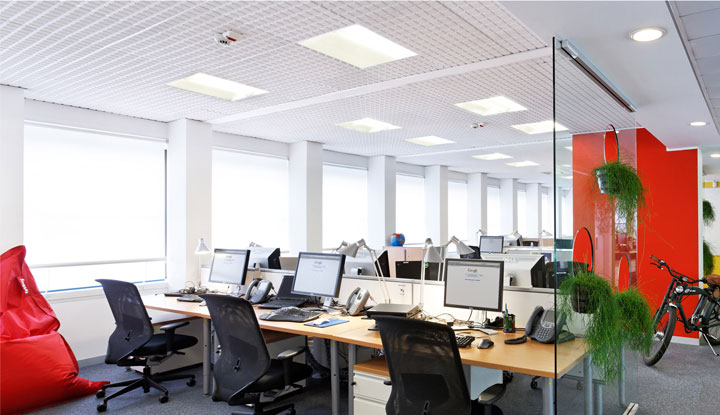Over the years, office design has changed and become more diversified based on the differing needs and demands of companies and work culture. We have seen cubicles, to open plan spaces, upper-management tucked away in private offices and even an installation, by the ad Agency TBWA (LA quarters), where employees simply grabbed a laptop on arrival and sat where they could find a seat.
Staying Connected Anytime, Anywhere
Today, with the ever increasing use of mobile and on-demand technology, common ideas about office design are (once again) changing. Employees are no longer tied to a central server which they need to access from a physical office space. The entire world is now practically interconnected to a non-stop wireless network with cloud accessibility.
Changes in how technology is used within the workplace has also impacted employee communication. Employees communicate differently, which means that businesses are beginning to re-imagine their work spaces. Meanwhile, as an employer, you have probably realized by now that strategies such as collaboration, networking, innovation, creativity and socializing are imperative to build a strong company culture.
Employees are also no longer confined to their desks. They are mobile and can connect (and do their work) on the go. It’s now more possible than ever for staff to work remotely, part-time or full-time. Not only does this allow employees a sense of independence, but businesses can down-size their physical space, save money and shift more ownership to employees. Hot-seats and communal meeting spaces are the way forward.
Work is an Experience, Employees Expect More
Gone are the private offices and partitions. Today’s forward-thinking workplaces have a flexible and home-like appeal. Even music rooms, day beds and games rooms are on the rise. What was once considered a disruptive model has proved to actually improve employee productivity.
When considering your office design take note that employees now want an experience rather than just a place to clock-in each day; and innovative employers are embracing this attitude with innovative office design solutions.
Here’s a look at companies at the forefront of making these changes to their office design are below.
- Google: Google offers several free in-house cafeterias, in-house fitness facilities, massage chairs, a free Macbook and free Nexus phones, indoor games and a slippery dip.
- Facebook: The social media juggernaut offers Foosball, snooker and table tennis equipment, gaming devices, in-house karaoke competitions and graffiti walls. Meanwhile the company was voted the best place to work by Glassdoor and Forbes Magazine.
- The 120 Media Collective: This #thinkinganddoing company boasts an antique Italian coffee machine that makes great coffees, spacious terraces for lunchtime and brainstorming, a ‘thinking room’ with a quiet environment, props left behind from shoots in the office.
- Corus Entertainment Canada: This company office space features a three-storey slide in its atrium and boardrooms shaped like ice hockey rinks.
- BBC North England: With giant neon “thought wheels” and security guards on segways zipping around, the interiors of the BBC North office resemble a scene from a sci-film.
If you are ready to let innovation lead in your office space consider the evolution of today’s workplace and incorporate some of these creative ideas to fuel a more collaborative company culture.
Irene Chen is an experienced corporate office designer and has worked on numerous innovative workspace projects for some of the world’s leading brands. Visit IC Corporate Interiors to find more information about Irene’s projects.
© YFS Magazine. All Rights Reserved. Copying prohibited. All material is protected by U.S. and international copyright laws. Unauthorized reproduction or distribution of this material is prohibited. Sharing of this material under Attribution-NonCommercial-NoDerivatives 4.0 International terms, listed here, is permitted.









